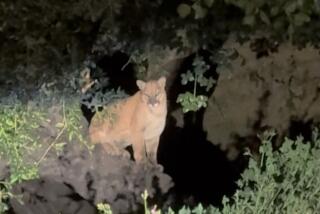An L.A. Community That’s on the Rise : El Monte: Close-in location, affordable prices and new homes all strong draws of this racially integrated neighborhood.
After years of renting in East Los Angeles, Lionel Alcarez was ready to own his piece of the American Dream. The year was 1957, and Alcarez had already looked at a number of houses in nearby Norwalk and Baldwin Hills when a three-bedroom, two-bathroom tract home in El Monte caught his eye.
“I had saved enough money for a down payment,” said Alcarez, recalling it was only $1,000, with a $100-a-month mortgage. “At that time, I wanted to get a place where it wasn’t too terribly far from work. I used to have some relatives out here who had lived here all their life, and they always talked about El Monte, talked about how it’s a good place to live.”
Back in those days, Alcarez worked at the Blue Diamond Cement Co. in downtown Los Angeles. A prime consideration of his was to find a place where his commute wouldn’t take longer than 20 minutes (traffic was much better in those days, he said), and although the homes in Norwalk and Baldwin Hills fit that bill, the one in El Monte had just been built and was priced at $2,500 less, a considerable savings when you realize the total price then was only $11,000.
Nowadays, Alcarez believes his house would sell for $180,000, but he has no plans to leave. He left his crane operator’s job at Blue Diamond in 1976 to work as a self-employed landscaper for commercial office buildings, and he now lives with his daughter and two grandsons in that same 1957 home. He described the area where he lives as a quiet, racially integrated neighborhood, and added, “My neighbors have lived here a long time as well, and they like it too.”
A growing city of 109,000, El Monte is sandwiched by Arcadia and Temple City to the north, South El Monte to the south, Baldwin Park to the east and Rosemead to the west. Within its solid working-class community, the El Monte population is 70% Latino, with 30% who are either Asians or Anglo.
More recently transplanted from East Los Angeles, 24-year-old medical assistant Rosa Nunez remembered the relief of leaving behind the crime problems of that area four years ago.
“I was scared to drive,” she said of certain sections of East L.A., mentioning the frequency with which cars were stolen. “Here everybody is friendly.”
Rosa and her husband, Braulio, 31, a sheet metal machine operator, moved into their 850-square-foot two-bedroom one-bath bungalow in 1988, soon after they got married. For $96,000, they have a big yard on the side where avocados and peaches grow, and an elementary school four blocks away that their daughter Jennifer, 4, and son, Marc, 2, will attend.
“It’s not bad here,” said Braulio Nunez. “There are some bad areas, but here it’s quiet.”
Both David Lamb of Century 21 George Michael Realty and Ophelia Macias of Century 21 Val Realty feel El Monte is on the rise again, even though other parts of greater Los Angeles remain depressed.
Lamb pointed to the many new townhomes that have been been built in the last four or five years, and Macias noted the heavy Asian investment in planned unit developments (PUDs), tight clusters of 700- to 3,000-square-foot homes. While typical older three-bedroom two-bath homes such as Alcarez’s sell for from $130,000 to $180,000, the average brand new 2,000-plus square-foot house in a PUD, with their smaller lot size, cost between $200,000 and $260,000.
“The area is really good compared to what it used to be 10 years ago,” said Dora Foster of Century 21 Earll Limited, who is also a long-time resident. Foster believes the influx of Asian immigrant investment in both El Monte’s residential and commercial sectors is making the city more attractive. A bastion of affordability amid the high housing prices of Los Angeles, Foster believes many Asians who might not have been able to buy into more pricey areas such as Arcadia now will take a long look at El Monte.
“This was the only place we could afford,” said Roland Lin, a 55-year-old bus operator who moved here with his wife, Nancy, and son, Larry, in 1988.
Lin purchased his three-bedroom, 2 1/2-bath townhome for $110,000, noting it was new while the other homes he’d seen were older. In addition, he says the fact that the San Bernardino (10), Pomona (60) and San Gabriel (605) freeways intersect El Monte makes his ethnic grocery shopping convenient. A third-generation Chinese-American, Lin said he can make the drive to either Monterey Park’s or downtown L.A.’s Chinatown in 15 or 20 minutes.
His only gripe is the recent switch of his bus route due to his company’s economic hardships. “I used to be able to walk to work--now I have to drive all the way out to Santa Monica,” he said.
Discovered in the 1770s by a group of Spanish soldiers and missionaries, El Monte was first settled during the great Gold Rush of 1849-50, when pioneer fortune seekers who headed west stayed behind to farm the land.
With a sign atop the entrance to the Valley Mall designating itself “The End of the Santa Fe Trail” (known to scholars as the Old Spanish Trail), El Monte was an agricultural community for a century, with thriving walnut groves and dairy farms its primary livelihoods. A featured attraction from 1923 to 1946 was Gay’s Lion Farm, world renowned as the home of African lions, and the location where the Tarzan movies with Johnny Weissmuller were shot.
Margie Wiggins, 84, who has lived here since her family owned El Monte’s first home with central heating, takes all of the city’s changes in stride.
“I have always said the only way I’ll leave is feet first, in a casket,” she said.
Wiggins has seen the Japanese gardens and chicken ranches give way to the industrial/commercial bases of Xerox and Westinghouse, and those in turn are now giving way to places such as Xiang Yun, a conglomerate from Beijing, China.
“(El Monte) has changed terrifically over the years, especially in the ethnic population,” she said.
“Demographic changes have come around several times,” said El Monte Union High School District Supt. David Sandell, who said that additional personnel and materials are made readily available to both non-English speaking Latino and Asian students.
“Overall, we have very safe schools, well-maintained and well-disciplined,” Sandell said. “We don’t have active gang participation in our school. We have a very good working relationship with the Police Department. If there’s any hint of problems they come to our campus and work closely on counseling and with the parents.”
Lee is free-lance writer living in West Los Angeles.
At a Glance
Population 1992 estimate: 110,588 1980-90 change: +30.8% Median age: 25.7 years *
Annual income Per capita: 8,895 Median household: 30,303 *
Household distribution Less than $30,000: 49.5% $30,000 - $60,000: 37.3% $60,000 - $100,000: 11.0% $100,000 - $150,000: 1.9% $150,000 +: 0.3%
More to Read
Start your day right
Sign up for Essential California for news, features and recommendations from the L.A. Times and beyond in your inbox six days a week.
You may occasionally receive promotional content from the Los Angeles Times.






